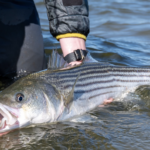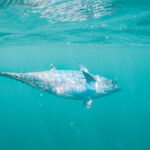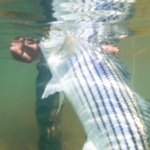
Talkin’ Striped Bass Spawn Dynamics
Consistent spawning production is paramount to a fishery’s long-term health. Many environmental factors are suspected
Feature Photo: “Best Practices for Fishing Cobia Around Manta Rays”
The Florida Manta Project is a pioneering initiative aimed at understanding and conserving the enigmatic manta rays inhabiting the Western Atlantic. Led by a team of dedicated researchers and conservationists, this project focuses on studying the behavior, ecology, and population dynamics of manta rays in Florida’s coastal waters. The project established an early collaborative relationship with anglers, acknowledging that the fishing community provides a wealth of experiential data from interactions on the water and verified time stamps to track distribution.
For southeast anglers, cobia have an established reputation as a prized catch, providing epic visual eats, thrilling fights and a (size-dependent) savory reward. They often “hitch a ride” with large marine life, creating their aquatic homestead amongst the presence of big sharks and rays. Due to this frequently observed symbiosis, cobia anglers are inclined to frequently interact with these unique marine megafauna. Many Florida fishermen mark their calendars for the “spring run”, hoping to cross paths with dozens of migrating mantas and pick off hearty cobia from their presence. These angling pursuits can have negative impacts on the rays, leaving “Christmas tree” mantas swimming around with a treasure chest of tackle shop jewelry. This is what we call a lose-lose situation: anglers miss out on cobia shots and lose expensive saltwater tackle while the rays wear the scars of these mishaps.
Utilizing a comprehensive community approach, the Florida Manta Project seeks to shed light on the mysteries surrounding these charismatic creatures and implement effective conservation strategies to ensure their long-term survival through angler collaboration. Healthier ray populations create more opportunity for anglers, and more efficient interactions mean less harm to rays and more fish in the boat for anglers, so the FMP team worked to create the following “Best Practices for Fishing Cobia Around Manta Rays”:
Jessica Pate from the Florida Manta Project stopped by The Guide Post Podcast this week to explain more about her background and the goals for the project. In the episode, Pate explains how gaps in Manta Ray understanding have been filled due to fishermen, but many still exist:
“So, these are the things I talk to fishermen about a lot, especially in South Florida. Because in South Florida, we have juvenile or baby manta rays. Anglers are always telling me, ‘I saw this giant manta ray! It was 10-feet!’ But 10-feet is still the juvenile. They’re born at 6-feet across. We actually think that the Mantas in the Western Atlantic and Caribbean are a new species of Manta. So, we don’t really have a good “maximum size” for the species, but their closest relative gets over 20-feet.”
Pate also explained how they put an emphasis on having anglers lead the conversation in this collaborative campaign. “We hope that the video reaches the right recreational anglers, and that since we have these credible fishing guides and anglers leading the video, they can connect as role models for anglers who don’t really know what they’re doing [and the impact].”
The campaign provides a positive example of a crossover between conservation communities. While the relationship between rays and cobia would likely be labeled as commensalism (one benefits while the other is largely unaffected), the collaboration between their passion communities represents one of mutualism: a true win-win.
Episode 135 is live now on all podcast platforms – Spotify & Apple Podcasts.
You can help expand the understanding of these incredible rays!
If you have documented any manta rays off the east coast in recent seasons, reach out to Jessica on Instagram (@FloridaMantaGirl) or by email (florida@marinemegafauna.org)!


Consistent spawning production is paramount to a fishery’s long-term health. Many environmental factors are suspected

While the ASGA team is extremely proud of the community we’re building with the Guide

Feature Image: A false albacore being landed off Jupiter Florida by the Cheeky Fishing team,

We caught this article a few days ago. Here’s the summary: Maryland striped bass commercial
We rely on our members and donations to keep fighting for a sustainable tomorrow in marine conservation.
By using this website, you agree to our use of cookies. We use cookies to provide you with a great experience and to help our website run effectively. To learn more, please review our privacy policy.